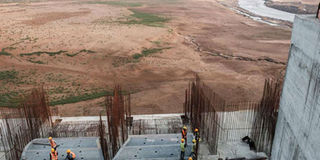Egypt, Ethiopia and Sudan fail to agree on Nile dam project

A general view of the construction works at the Grand Ethiopian Renaissance Dam (GERD), near Guba in Ethiopia, on December 26, 2019. PHOTO | EDUARDO SOTERAS | AFP
What you need to know:
- The three countries gathered in Ethiopia's capital, Addis Ababa, to discuss how to fill up the new Grand Renaissance Dam (GERD) without affecting the flow of water to Sudan and Egypt.
- But the ministers of water resources and technical delegations failed to merge their divergent views on how long it should take to fill the dam.
- Egypt fears that the dam will reduce its share of the Nile water while Ethiopia stresses the need for the dam to generate electricity.
- It is now expected that ministers from the three countries will meet in Washington next week to provide more details on the results of the talks.
Egypt, Ethiopia and Sudan have failed to reach an amicable deal on how to fill up the controversial dam on the Nile, opening another round of uncertainty on how to share the waters.
The three countries gathered in Ethiopia's capital, Addis Ababa, to discuss how to fill up the new Grand Ethiopian Renaissance Dam (GERD) without affecting the flow of water to Sudan and Egypt.
The countries had hoped that the final negotiations would solve technical issues as well as the related rules of filling and operation.
But their ministers of water resources and technical delegations failed to merge their divergent views on how long it should take to fill the dam.
TIME NEEDED
The negotiations, first proposed by the United States and supported by the World Bank, were meant to ensure that Ethiopia’s $5 billion GERD on the Blue Nile fills up for its planned irrigation, and hydro-electric power production, without affecting water supply to Sudan and Egypt.
The two countries heavily rely on the Nile, 80 per cent of whose water is sourced from Ethiopia.
In Addis Ababa, Ethiopia and Egypt disagreed on the time needed to fill the dam.
While Addis Ababa argued for seven years, Egyptians suggested between 12 and 21 years, which they said will sustain Cairo's water supply needs as the dam fills slowly.
KEY CONCERNS
Egypt fears that the dam will reduce its share of the Nile water while Ethiopia stresses the need for the dam to generate electricity.
Egyptian minister Mohamed Abdel-Atti stuck to a previous proposal for progressive filling and enabling Ethiopia to generate hydroelectric power and achieve development.
The proposal included provisions for drought mitigation, which may coincide with the period of filling the dam, as well as a fair and balanced operating rules that would enable Addis Ababa to engage in sustainable hydroelectric generation while maintaining the operation of Al-ssad Al-ally Dam in Egypt.
Cairo and Khartoum argue that any faster filling of the dam could expose countries downstream Egypt, yet they are already suffering a significant water shortage of 21 billion cubic metres.
Ethiopia’s proposal, Egypt feels, will reduce the volume of water, but Abdel-Atti said there will be further discussions to bridge the gap on these issues.
Regarding the timeline, Ethiopian Minister of Water and Irrigation, Seleshi Bekele, said, "The Egyptian delegation came up with a new template of ideas for the process of filling the dam, setting a timetable between 12 to 21 years, which is unacceptable to us."
The minister said his country will begin the process of filling the dam in July.
WASHINGTON MEETING
It is now expected that ministers from the three countries will meet in Washington next week to provide more details on the results of the talks.
The United States and the World Bank have offered to help mediate.
The first meeting was held in Ethiopia on November 15 and 16, 2019 and the second one on December 2 and 3.
Another meeting took place in Washington on December 9 at the invitation of the US Treasury secretary and in the presence of the World Bank President, and was following by yet another in Khartoum on December 20 and 21.




